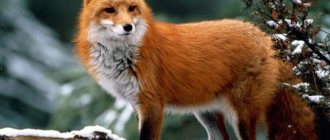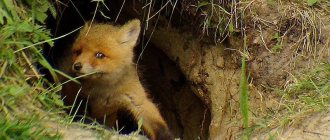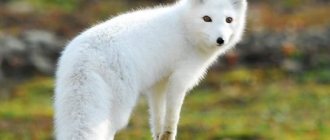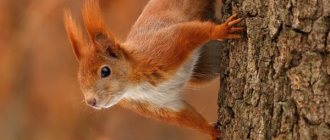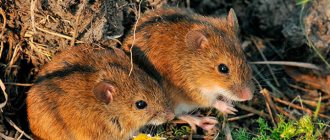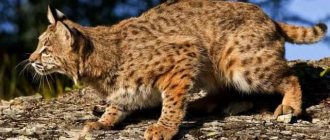27 March17626canine familypredator fox
The common or red fox is a predatory representative of the Canidae family. The red fox is one of the most common characters in children's fairy tales around the world, where it represents cunning and dexterity. This perceptive beauty with a fiery color and fluffy coat is very careful, she easily confuses her tracks and gracefully evades pursuit. Below you will find a description of the fox and a photo, and also learn a lot of new and interesting things about this animal.
Description
Fox on a fallen tree
Foxes are widespread in Russia and other countries where there are suitable conditions for their life. The animal is a predator and hunts small animals, rodents and insects, thereby regulating populations and preventing overpopulation of a certain species. This allows us to maintain balance in nature.
Externally, the fox is easy to distinguish from other canines due to its bright red color. This often turns against the predator, since it can be seen even through dense forest thicket.
How many years do they live
Corsac
The life expectancy of a fox in natural conditions does not exceed 4-5 years. Most often, foxes die from disease, attacks by wolves and other large predators, and from lack of food in too cold and long winters. Adult males die during fights with rivals. Foxes have beautiful and warm fur, and have always been considered a valuable hunting trophy. Sometimes shooting is carried out not for the sake of fur, but in order to prevent the spread of diseases carried by foxes.
The age of animals kept in captivity can reach 20 years or more.
Fox appearance
The appearance of a fox
The appearance of a fox
Fox appearance
Fox appearance
Fox appearance
The appearance of a fox depends directly on the climate where it lives. In warm regions, these animals grow small in size and have a bright orange color. In cold conditions, larger individuals are found wearing light orange fur.
Interesting fact : in the mountains there are sometimes black-brown foxes, which is why they are often confused with other animals.
The predator's belly is light and its paws are black. The color of the tail is most often tricolor, combining stripes of orange, brown and white fur. Large individuals can grow up to 80 cm in length and up to 40 cm in height. Weight varies from 6 to 10 kg.
Genus Gray foxes
Gray fox (Urocyon cinereoargenteus)
The gray fox is a very dexterous and agile animal, which, unlike other foxes, can climb trees. A distinctive feature of this fox is the black stripe on its tail, which stretches from its base to the end. Its sides, neck and paws are a basic dark brown color, and its belly is white. The back, head and tail are gray. Pairs are created once and for life. This fox is hunted for its soft fur.
Island fox (Urocyon littoralis)
Externally, in color, this fox is no different from the Gray fox living on the continent. It differs only in its size. Animals that live on islands most often become dwarfs. This fox is no larger than a cat. The fox is a clear example of insular dwarfism, which usually occurs due to food scarcity and relative safety. The main enemy of this fox is the golden eagle, which is the main cause of mortality for this species.
Lifestyle and behavior
Foxes prefer to live in packs
Foxes prefer to live in packs, consisting of an older male, a female and their cubs. In fact, these predators live in full-fledged families. As a home, they choose an area where there is enough food and there is loose soil for digging holes. Foxes live in the latter, and sometimes they can occupy a hole made by another animal. Cases have been recorded when predators inhabited part of the underground tunnels made by badgers and existed side by side with them without entering into conflict. When inhabiting a territory, foxes can dig several holes leading to one nest located underground.
If for some reason a fox lives alone, it may not dig a hole at all, using thick grass, snowdrifts, etc. as a place to sleep.
In its lifestyle, the predator is largely nocturnal. Possessing excellent eyesight, he has excellent orientation in the dark, which allows him to track down prey. When going hunting, the fox prefers to move in a straight line so as not to go astray.
Interesting: Nature - what is nature, the nature of the world, photos and videos
Red fox behavior
Throughout their wide distribution range, foxes prefer open areas, as well as areas with isolated groves, copses, hills and ravines.
Among all climatic zones, the largest number of representatives of this species lives in the steppe and forest-steppe zone. Foxes are usually sedentary and do not migrate. During resettlement, young individuals leave the den of their parents at a distance of 2-5 to 15-30 km. A pair or group of foxes occupies the so-called family plot, where the animals dig holes on their own or occupy the homes of a badger, marmot, or arctic fox. Foxes can even live in the same hole with badgers. Animals also use natural shelters such as caves, rock crevices, and tree hollows.
Foxes usually live on the slopes of ravines and hills, in areas with sandy soil, protected from floods. Each burrow has several entrances, from which long tunnels lead to the nesting chamber. A fox's burrow is always camouflaged by dense thickets, but food debris and paths trodden to the entrances can give it away.
Foxes hunt throughout the day, but prefer early morning and late evening. In general, they are extremely careful, they know how to hide well and throw off the chase, which is why for many peoples this animal symbolizes cunning and dexterity.
Fox voice
Foxes make virtually no sounds, preferring to communicate with each other using smells. When an individual wants to leave a certain message for others, it marks the territory with products of its body.
However, if the predator still needs to make a voice, it may begin to growl or bark. The voices of males and females are different. The former produce rougher and bassier sounds, while females have a ringing voice. You can hear the fox in those moments when it is in danger or feels anxious.
Folklore
It is impossible to imagine Russian folklore without mentioning the red fox. Along with the bear, wolf and hare, the fox is one of the main characters in many folk tales. In these tales, the fox usually symbolizes cunning, and is referred to only as “cheat,” cunning “godfather,” or “sister.”
Given this peculiarity of perception, it will be strange for us to learn that in Japan the characteristic of a fox is extremely unpleasant and dark - something close to a demon. Such an enemy of the entire human world in Japanese mythology loves to inhabit the bodies of others. The fox in their fairy tales feeds on the power of human life, replacing ordinary thoughts with terrible illusions, and dreams with nightmares.
Movement
In a calm environment, the animal moves with a straight gait, with its legs almost fully extended. Experienced hunters can easily identify a fox track in the snow by the characteristic small steps that line up in a continuous chain.
Having seen its prey, the fox lies almost completely close to the ground and begins to slowly creep up to it. Having waited for the right moment, she rushes forward, pouncing on the target. To maneuver, the predator uses a long tail, which acts as a rudder. It allows you to maintain balance and fit into turns if the prey suddenly decides to run to the side.
Interesting fact : despite their thin legs, foxes are well developed physically. They easily catch up with prey and can pursue it for a long time, and their maximum speed reaches 48 km/h.
Foxes have well-developed senses of smell and hearing, thanks to which they can accurately determine the location of prey even before they see it. This helps to immediately duck down and start closing the distance.
Weight
Fox skins are measured by length on standard boards. The skins are placed belly down, head towards the specialist. The length of the skin is determined from the tip of the nose to the base of the tail.
| Code | Weight | Definition |
| HVY | HEAVY | Very deep underfur. Long hair (long hair type) |
| AVG | AVERAGE | Average depth of underfur. Medium pile (medium hair type) |
| FL | VERY FLAT | Short underfur. Short pile (short pile type) |
| XFL | FLAT | Very low undercoat. Mainly covering hair. |
Habitat - where does the fox live?
Habitat of the red fox Foxes
live in almost all regions of Russia, choosing forests and plains as their habitat. Thanks to their warm fur, they can survive even in cold conditions, and if necessary, keep warm with the help of their bushy tail. Foxes also thrive in the mountains and tundra, adapting to the surrounding conditions.
The only area where foxes cannot be found in Russia is the most extreme regions of the north. Even for such adapted predators, the local weather is unfavorable, and the almost complete lack of suitable food forces them to stay away from these lands altogether.
The southern and central regions are considered the most favorable regions in Russia for foxes. They settle in numerous forests and steppes, where numerous species of rodents live.
Red fox distribution
The distribution range of the fox is very wide: it lives throughout Europe, in northern Africa (Egypt, Algeria, Morocco, Tunisia), in Asia (to northern India, southern China and Indochina), in North America from the Arctic to the northern Gulf of Mexico.
The fox was acclimatized in Australia, and it took root on the continent, except for the subequatorial regions. — Advertising —
Foxes are unpretentious animals and inhabit all landscape and geographical zones: from the tundra and subarctic forest to the steppe and deserts, as well as mountains. Moreover, they are found not only in the wild, but also on the outskirts of cities, inhabiting landfills, parks and basements of houses.
Nutrition
The hare is one of the delicious dishes of the fox.
Foxes are considered omnivores. Their diet consists of more than 400 species of different animals, as well as dozens of plants and fruits. Predators do not hesitate to feed on insects and carrion.
Predators living in Russia mainly feed on voles and other rodents. They are not able to escape from the red predator, so they become easy prey. If necessary, a fox can dig up the ground or a snowdrift in a matter of seconds to get to its target. She will also not miss the opportunity to feast on a hare and other small animals. In hungry times, the animal can switch to carrion and plants.
Interesting: Plants of the Red Book of Russia - description, photos, videos, features, where they grow
Interesting fact : in Canada, foxes can feed on salmon washed ashore during the spawning season.
In case of severe food shortage, the fox may not be afraid to come to the local village, where he will try to find chickens and other poultry and small animals.
Varieties
Redhead (red)
The species is the most common and largest in number. The red fox is found throughout the entire Northern Hemisphere, as well as on the Australian continent.
Gray
Registered on the lands of North America. This species is distinguished from the common fox by a more spectacular coat, which combines grayish-black and red colors. They are also distinguished by their ability to climb trees well.
Black-brown
At its core, this is a subspecies of the red fox breed, which is distinguished by changes in the pigmentation of fur colors. However, this change arouses genuine interest among fur connoisseurs, due to which this species is actively grown by breeders.
Arctic (Arctic fox)
They live beyond the Arctic Circle, where very thick fur helps them cope with the cold. The northern fox is distinguished by the small size of its body, paws and muzzle.
fennec
Inhabitants of the African continent, whom nature itself has adapted to the highest temperatures. She gave these cute animals large ears and cream-colored fur that does not collect the heat of the scorching sun.
Reproduction and offspring
Fox with cubs
Females are able to give birth already in the second year of life, and males reach maturity only in the third. The breeding season for foxes falls in the winter, and several males can compete for the attention of one female.
Preparing to give birth to offspring, the fox carefully prepares its den, clearing out all the garbage from it. When the cubs are born, they are cared for by both parents. On average, five fox cubs are born at a time. For the first two weeks they are blind and deaf, and their mother spends all the time with them. The male obtains food by bringing it to the female. Foxes are one of the few animals in which the male remains with the female after the offspring are born.
After a week and a half, the fox cubs begin to see and hear, and they are teething. They grow quickly and after 15 days they can come out of the hole and taste the meat left by their father. At the age of one and a half months, the cubs begin to learn how to hunt and survive in the surrounding conditions. Having become stronger and having learned everything they need, they can leave to settle in new territories or settle close to their parents.
Subfamily Big-eared foxes (Otocyoninae)
Big-eared foxes (Otocyon megalotis)
The bat-eared fox is common in two regions of Africa, where herbivorous termites live. It inhabits semi-deserts and dry savannas. In winter she is diurnal, and in summer she is nocturnal. The presence of 48 teeth is the main distinguishing feature of this species. It almost never eats plant foods and does not attack domestic animals. The ears, which help cool the body in the heat and hear the movement of prey well, are 13 cm long. It has only one subspecies - Otocyon megalotis virgatus. Foxes are monogamous. Once a year, a female gives birth to 2-6 puppies, but since she has only four nipples, she kills weak foxes. The threat to the fox comes from local residents who kill it for its fur and meat.
If you liked this material, share it with your friends on social networks. Thank you!
Natural enemies
The wolf is one of the main enemies of the fox.
Natural enemies depend on the fox’s habitat. In fact, the animal may come into conflict with larger predators living nearby. These include wolves, bears, wolverines, and lynx. Large birds can cause certain troubles: eagles, falcons, hawks and golden eagles.
There have been cases when badgers and ferrets fought back against the fox, putting up serious resistance when caught. As a result, they managed to fight off the predator.
Enemies of foxes in the wild
Since ancient times, foxes have been known as cunning and cautious animals. They had such qualities for a reason. Foxes have many enemies from which they need to somehow escape.
Some animals deliberately attack tailed animals. Among the enemies of foxes:
- wolverine;
- bear;
- wolf;
- large birds of prey (for example, eagle and golden eagle);
- a larger fox of a different species;
- predatory cats (lynxes, pumas, leopards, tigers);
- domestic dog;
- badger.
Eagle owls, crows and hawks also attack the cubs of red predators.
Why is the fox cunning?
A fox can cover its tracks with its tail.
Since the Middle Ages, many people have called the fox cunning. And it was not by chance that such a stereotype stuck to her. The fact is that she is able to show great ingenuity during the hunt. A predator can sit near a hole for hours waiting for prey to emerge from it. He also knows how to sneak up on a target unnoticed, acting very cunningly: all the time remaining in the shadows and hiding behind trees.
The beast also shows cunning in times of danger. To confuse hunters, the fox is capable of confusing its own tracks, constantly changing direction and moving in circles.
Interesting fact : the fox uses its tail to cover its tracks. Moving through snowdrifts, she can cover the marks from her paws with snow right as she goes.
Genus Falkland foxes (Dusicyon)
Falkland fox (Dusicyon australis)
This is an extinct species of fox that was discovered in 1692 by Captain John Strong in the Falkland Islands. This fox was uncontrollably shot by hunters for its fur and poisoned, as it posed a threat to flocks of sheep. The last fox was killed in 1876. Specimens of this fox can be found in museums in London, Brussels, Leiden and Stockholm. Her image can be seen on the reverse of the Falkland Islands 50p coin.
Domestication
An ordinary fox quickly gets used to home and comfort, becoming a tame animal. She can be litter box trained and trained to follow various commands. Since the animal is not picky about food, it is easy to maintain: it is enough to regularly feed it with dog food, periodically diluting the diet with meat and vegetables.
Interesting: Snow leopard
